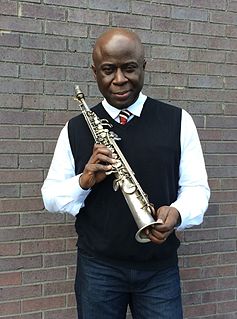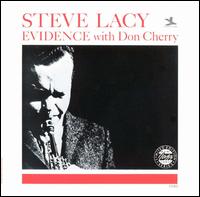Related Research Articles

The saxophone is a type of single-reed woodwind instrument with a conical body, usually made of brass. As with all single-reed instruments, sound is produced when a reed on a mouthpiece vibrates to produce a sound wave inside the instrument's body. The pitch is controlled by opening and closing holes in the body to change the effective length of the tube. The holes are closed by leather pads attached to keys operated by the player. Saxophones are made in various sizes and are almost always treated as transposing instruments. Saxophone players are called saxophonists.

Steve Lacy was an American jazz saxophonist and composer recognized as one of the important players of soprano saxophone. Coming to prominence in the 1950s as a progressive dixieland musician, Lacy went on to a long and prolific career. He worked extensively in experimental jazz and to a lesser extent in free improvisation, but Lacy's music was typically melodic and tightly-structured. Lacy also became a highly distinctive composer, with compositions often built out of little more than a single questioning phrase, repeated several times.

Wayne Shorter is an American jazz saxophonist and composer. Shorter came to prominence in the late 1950s as a member of, and eventually primary composer for, Art Blakey's Jazz Messengers. In the 1960s, he joined Miles Davis's Second Great Quintet, and then co-founded the jazz fusion band Weather Report. He has recorded over 20 albums as a bandleader.
Joan Linda La Barbara is an American vocalist and composer known for her explorations of non-conventional or "extended" vocal techniques. Considered to be a vocal virtuoso in the field of contemporary music, she is credited with advancing a new vocabulary of vocal sounds including trills, whispers, cries, sighs, inhaled tones, and multiphonics.
Larry Don Austin was an American composer noted for his electronic and computer music works. He was a co-founder and editor of the avant-garde music periodical Source: Music of the Avant Garde. Austin gained additional international recognition when he realized a completion of Charles Ives's Universe Symphony. Austin served as the president of the International Computer Music Association (ICMA) from 1990 to 1994 and served on the board of directors of the ICMA from 1984 to 1988 and from 1990 to 1998.

The alto saxophone, also referred to as the alto sax, is a member of the saxophone family of woodwind instruments. Invented by Belgian instrument designer Adolphe Sax in the 1840s and patented in 1846, it is pitched in E♭, smaller than the tenor but larger than the soprano. It is the most common saxophone and is commonly used in popular music, concert bands, chamber music, solo repertoire, military bands, marching bands, and jazz. The fingerings of the different saxophones are all the same, so a saxophone player can play any type of saxophone.

The soprano saxophone is a higher-register variety of the saxophone, a woodwind instrument invented in the 1840s. The soprano is the third-smallest member of the saxophone family, which consists of the soprillo, sopranino, soprano, alto, tenor, baritone, bass, contrabass saxophone and tubax. Soprano saxophones are the smallest and thus highest-pitched saxophone in common use.
Phillip Wayne Barham is a classical and jazz saxophonist was the professor of saxophone at Tennessee Technological University in Cookeville, Tennessee until October 2018.
Leonard Candelaria is an American trumpeter and educator residing in Birmingham, Alabama. Until Fall 2009, he served as Professor of Trumpet and Artist in Residence at the University of Alabama at Birmingham (UAB). Prior to his appointment at UAB, Leonard was, for 28 years, professor of trumpet at the University of North Texas College of Music, where he was eventually named Regents Professor of Music in the College of Music. He is recognized internationally as a teacher and performer, and has been a featured soloist in numerous concerts all over the world. He has often been praised for his high level of musicianship and artistry.
Rodney Waschka II is an American composer known for his algorithmic compositions and his theatrical works.

Sam Newsome is an American jazz saxophonist, composer, and educator. His music combines straight-ahead jazz, world music and experimental jazz, which uses extended techniques. Newsome is an associate professor of music and the coordinator of the music program at Long Island University's Brooklyn Campus.

Evidence is the fourth album by Steve Lacy and was released on the New Jazz label in 1962. It features performances of four tunes written by Thelonious Monk and two from Duke Ellington by Lacy, Don Cherry, Carl Brown and Billy Higgins.

Only Monk is the third album by Steve Lacy to be released on the Italian Soul Note label. It features solo performances of nine tunes written by Thelonious Monk by Lacy. It is the second solo album composed totally of Monk's compositions recorded by Lacy following Eronel (1979) and follows a tradition established on Lacy's second album Reflections (1958) and Epistrophy (1969).
Richard Karpen is an American composer of electronic and acoustic music. He is also known for developing computer applications for music and composition.
JB Floyd is an American concert pianist, composer, and music pedagogue at the collegiate level. Before retiring in 2013, Floyd had spent 64 years as a music educator in higher education, notably as Chairman of Keyboard Performance, at Northern Illinois University from 1962 to 1981 and Chairman of Keyboard Performance at the University of Miami Frost School of Music from 1982 to 2013. Floyd is a Yamaha Artist.

Patrick Zimmerli is an American saxophonist, composer, arranger, and record producer.
Rick VanMatre is an American saxophonist, composer, conductor and educator. As a musician, he has performed as a soloist with the New York Repertory Orchestra and the Cincinnati Chamber Orchestra, and recorded with the Cincinnati Pops Orchestra and PsychoAcoustic Orchestra. VanMatre has produced numerous albums, including Serenade in Blue and currently performs as the leader of the Rick VanMatre Quintet.
Joe Daley was an American jazz tenor saxophonist, composer, and music teacher. Daley was part of the Chicago jazz scene for 40 years. Musicians who studied with Daley include Grammy winners David Sanborn and Paul Winter, Emmy winner James DiPasquale, Richard Corpolongo, Chuck Domanico, and John Klemmer.

Ninetet (Yoshi's) 1997 Vol. 1 is a live album by composer and saxophonist Anthony Braxton with a ninetet, recorded at the Yoshi's in 1997 and released on the Leo label in 2002 as a double CD.

We See, subtitled Thelonious Monk Songbook, is a live album by soprano saxophonist Steve Lacy, which was recorded in Switzerland in 1992 and first released on the hat ART label in 1993. The album was rereleased in 2002 with an additional track from the concert.
References
- ↑ "Steve Duke : Saxophone - Feldenkrais Teacher". Steve Duke. Retrieved 2014-06-12.
- 1 2 3 4 Steve Duke – NIU – School of Music Archived 2008-02-16 at the Wayback Machine
- ↑ "Gain Without Pain Feldenkrais Therapy Shows How Small Changes in How You Move Can Have a Big Impact on How You Feel". Daily Herald; Arlington Heights, Ill. redOrbit. April 18, 2005. Archived from the original on May 22, 2011. Retrieved June 6, 2016.
- ↑ Institut International de Musique Electroacoustique de Bourges – France – IMEB – GMEB – FESTIVAL SYNTHESE
- ↑ EMF Media Larry Austin
- ↑ elillios.com Archived 2011-09-01 at the Wayback Machine
- ↑ CMJ Reviews [ permanent dead link ]
- ↑ 2001 New Music Festival @ ECU
- ↑ Music
- 1 2 Capstone Records: Saint Ambrose
- ↑ Steve Duke / Joe Pinzarrone - Monk By 2
- ↑ Cdcm Series Vol 23 – Composer In The Computer Age Vol 6 | ArkivMusic
- ↑ Centaur Records – Centaur Records – Classical Record Label